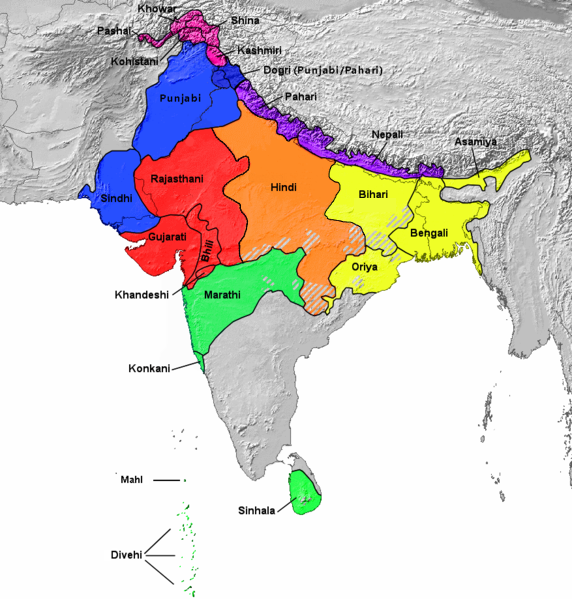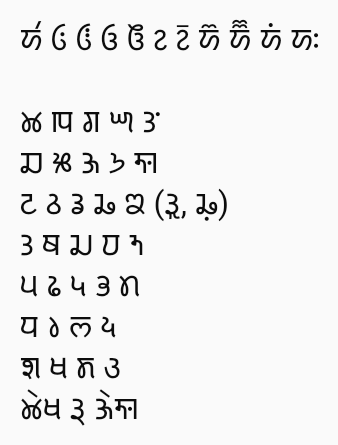|
Hinduri Language
Hinduri (or Handuri) is a Western Pahari language of northern India. It was classified as a dialect under the Kiunthali Group Script Status The language is commonly called Pahari or Himachali. Some speakers may even call it a dialect of Punjabi or Dogri Dogri ( Name Dogra Akkhar: ; Devanagari: डोगरी; Nastaliq: ; ) is an Indo-Aryan language primarily spoken in the Jammu region of Jammu and Kashmir, India, with smaller groups of speakers in adjoining regions of western Himachal Prad .... The language has no official status. According to the United Nations Education, Scientific and Cultural Organisation (UNESCO), the language is of critically endangered category, i.e. the youngest speakers of Handuri are generally grandparents or older and they too speak it infrequently or partially. The demand for the inclusion of 'Pahari (Himachali)' under the Eight Schedule of the Constitution, which is supposed to represent multiple Pahari languages of Himachal Prade ... [...More Info...] [...Related Items...] OR: [Wikipedia] [Google] [Baidu] |
India
India, officially the Republic of India (Hindi: ), is a country in South Asia. It is the seventh-largest country by area, the second-most populous country, and the most populous democracy in the world. Bounded by the Indian Ocean on the south, the Arabian Sea on the southwest, and the Bay of Bengal on the southeast, it shares land borders with Pakistan to the west; China, Nepal, and Bhutan to the north; and Bangladesh and Myanmar to the east. In the Indian Ocean, India is in the vicinity of Sri Lanka and the Maldives; its Andaman and Nicobar Islands share a maritime border with Thailand, Myanmar, and Indonesia. Modern humans arrived on the Indian subcontinent from Africa no later than 55,000 years ago., "Y-Chromosome and Mt-DNA data support the colonization of South Asia by modern humans originating in Africa. ... Coalescence dates for most non-European populations average to between 73–55 ka.", "Modern human beings—''Homo sapiens''—originated in Africa. Then, int ... [...More Info...] [...Related Items...] OR: [Wikipedia] [Google] [Baidu] |
Nalagarh
Nalagarh is a city and a municipal committee, near the city of Solan in Solan district in the Indian state of Himachal Pradesh. Geography Nalagarh is a gateway to Himachal Pradesh in North India, from Shimla, from Delhi and from Chandigarh. History The Fort of Nalagarh was built in 1421 during the reign of Raja Bikram Chand on a hillock at the foothills of the mighty Himalayas. It affords a panoramic view of the Shivalik hills beyond the Sirsa river and gave its name to the state. Nalagarh enjoyed indirect rule during the British Raj as a non-salute state. In the early twentieth century, Nalagarh State was one of the Shimla, Simla hill states, under the government of Punjab region, Punjab. The country was overrun by Gurkhas for some years before 1815, when they were driven out by the British Empire, British, and the raja was confirmed in possession of the territory. Grain and opium were the main agricultural products. Rulers Governance Nalagarh is a municipal cou ... [...More Info...] [...Related Items...] OR: [Wikipedia] [Google] [Baidu] |
Himachal Pradesh
Himachal Pradesh (; ; "Snow-laden Mountain Province") is a state in the northern part of India. Situated in the Western Himalayas, it is one of the thirteen mountain states and is characterized by an extreme landscape featuring several peaks and extensive river systems. Himachal Pradesh is the northernmost state of India and shares borders with the union territories of Jammu and Kashmir and Ladakh to the north, and the states of Punjab to the west, Haryana to the southwest, Uttarakhand to the southeast and a very narrow border with Uttar Pradesh to the south. The state also shares an international border to the east with the Tibet Autonomous Region in China. Himachal Pradesh is also known as , meaning 'Land of Gods' and which means 'Land of the Brave'. The predominantly mountainous region comprising the present-day Himachal Pradesh has been inhabited since pre-historic times, having witnessed multiple waves of human migrations from other areas. Through its history, the ... [...More Info...] [...Related Items...] OR: [Wikipedia] [Google] [Baidu] |
Indo-Iranian Languages
The Indo-Iranian languages (also Indo-Iranic languages or Aryan languages) constitute the largest and southeasternmost extant branch of the Indo-European languages, Indo-European language family (with over 400 languages), predominantly spoken in the Subregion, geographical subregion of United Nations geoscheme for Asia#Southern_Asia, Southern Asia. They have more than 1.5 billion speakers, stretching from Europe (Romani language, Romani), Mesopotamia (Kurdish languages, Zaza–Gorani languages, Zaza–Gorani and Kurmanji#Dialect continuum, Kurmanji Dialect continuum) and the Caucasus (Ossetian language, Ossetian, Tat language (Caucasus), Tat and Talysh language, Talysh) eastward to Xinjiang (Sarikoli language, Sarikoli) and Assam (Assamese language, Assamese), and south to Sri Lanka (Sinhala language, Sinhala) and the Maldives (Maldivian language, Maldivian), with branches stretching as far out as Oceania and the Caribbean for Fiji Hindi and Caribbean Hindustani respectively. Fur ... [...More Info...] [...Related Items...] OR: [Wikipedia] [Google] [Baidu] |
Indo-Aryan Languages
The Indo-Aryan languages (or sometimes Indic languages) are a branch of the Indo-Iranian languages in the Indo-European languages, Indo-European language family. As of the early 21st century, they have more than 800 million speakers, primarily concentrated in India, Pakistan, Bangladesh, Nepal, Sri Lanka, and Maldives. Moreover, apart from the Indian subcontinent, large immigrant and expatriate Indo-Aryan–speaking communities live in Northwestern Europe, Western Asia, North America, the Caribbean, Southeast Africa, Polynesia and Australia, along with several million speakers of Romani languages primarily concentrated in Southeast Europe, Southeastern Europe. There are over 200 known Indo-Aryan languages. Modern Indo-Aryan languages descend from Old Indo-Aryan languages such as early Vedic Sanskrit, through Middle Indo-Aryan languages (or Prakrits). The largest such languages in terms of First language, first-speakers are Hindustani language, Hindi–Urdu (),Standard Hindi firs ... [...More Info...] [...Related Items...] OR: [Wikipedia] [Google] [Baidu] |
Northern Indo-Aryan Languages
The Northern Indo-Aryan languages, also known as Pahāṛi languages, are a proposed group of Indo-Aryan languages spoken in the lower ranges of the Himalayas, from Nepal in the east, through the Indian states of Jammu and Kashmir, Uttarakhand, Himachal Pradesh and Punjab(not to be confused with the various other languages with that name) was coined by G. A. Grierson. Classification The Pahari languages fall into three groups. Eastern Pahari * Nepali is spoken by an estimated 11,100,000 people in Nepal, 265,000 people in Bhutan, and 2,500,000 people in India. It is an official language in Nepal and India. * Jumli is spoken by an estimated 40,000 people in the Karnali zone of Nepal. *Doteli spoken by an estimated 1 million people in far west Nepal. It is considered by many to be a dialect of Nepali, according to some scholars (e.g., Rahul Sankrityayan), a dialect of Kumaoni, but the Nepalese Language Commission considers it a separate language. Central Pahari * Kumaoni ... [...More Info...] [...Related Items...] OR: [Wikipedia] [Google] [Baidu] |
Western Pahari
The Western Pahari languages are a group of Northern Indo-Aryan languages that are spoken in the state of Himachal Pradesh, Jammu region of Jammu and Kashmir and parts of Uttarakhand and Punjab Languages The following lists the languages classified as belonging to Western Pahari, with the provisional grouping used in Glottolog 4.1: :Jaunsari :Nuclear Himachali: :: Hinduri :: Pahari Kinnauri :: Kullu Pahari ::Mahasu Pahari ::Sirmauri :Mandeali :Kangric-Chamealic-Bhattiyali: ::Chamealic: :::Bhadarwahi ::: Churahi ::: Bhattiyali :::Bilaspuri :::Chambeali ::: Gaddi :::Pangwali ::Kangri-Dogri: :::Dogri :::Kangri These languages are a dialect chain, and neighbouring varieties may be mutually intelligible. Some Western Pahari languages have occasionally been regarded as dialects of either Dogri, Hindustani or Punjabi. Some Western Pahari languages, notably Dogri and Kangri, are tonal, like their close relative Punjabi but unlike most other Indic languages. Dogri has been an offic ... [...More Info...] [...Related Items...] OR: [Wikipedia] [Google] [Baidu] |
Takri
The Tākri script (Takri (Chamba): ; Takri (Jammu/Dogra): ; sometimes called Tankri ) is an abugida writing system of the Brahmic family of scripts. It is derived from the Sharada script formerly employed for Kashmiri. It is the sister script of Laṇḍā scripts. It is another variant of Dogra Takri (also known as Dogra Akkhar) employed in Jammu region. Chamba Takri was considered by Grierson as the standard form of Takri, primarily because it was the first variety that was developed for print. In addition to Chamba and Dogra, there are numerous varieties, “with each Hill State or tract having its own style.” Until the late 1940s, the adapted version of the script (called Dogri, Dogra or Dogra Akkhar) was the official script for writing Dogri in the princely state of Jammu and Kashmir and for Kangri, Chambyali and Mandyali in Himachal Pradesh. However, the Takri script used in the Sirmour in Himachal Pradesh and Jaunsar-Bawar region has some distinction. History The ... [...More Info...] [...Related Items...] OR: [Wikipedia] [Google] [Baidu] |
Devanagari
Devanagari ( ; , , Sanskrit pronunciation: ), also called Nagari (),Kathleen Kuiper (2010), The Culture of India, New York: The Rosen Publishing Group, , page 83 is a left-to-right abugida (a type of segmental Writing systems#Segmental systems: alphabets, writing system), based on the ancient Brahmi script, ''Brāhmī'' script, used in the northern Indian subcontinent. It was developed and in regular use by the 7th century CE. The Devanagari script, composed of 47 primary characters, including 14 vowels and 33 consonants, is the fourth most widely List of writing systems by adoption, adopted writing system in the world, being used for over 120 languages.Devanagari (Nagari) , Script Features and Description, SIL International (2013), United States The orthography of this script reflects the pr ... [...More Info...] [...Related Items...] OR: [Wikipedia] [Google] [Baidu] |
Pahari Language
Pahari, or Pahadi ( 'of the hills/mountains'; ) is an ambiguous term that has been used for a variety of languages, dialects and language groups, most of which are found in the lower Himalayas. Most commonly, it refers to: * Pahari-Pothwari, the predominant language of Pakistan-administered Azad Kashmir and neighbouring areas of Punjab and Indian-administered Jammu and Kashmir * individual Western Pahari languages spoken primarily in the Indian state of Himachal Pradesh, with some languages in the south-eastern parts of Indian Jammu and Kashmir, * Northern Indo-Aryan languages, in the linguistics literature often referred to as "Pahari languages", a proposed group that includes the Indo-Aryan languages of Nepal and the Indian states of Uttarakhand and Himachal Pradesh. Less commonly, ''Pahari'' may be: * a term used by Dogri speakers of the plains to refer to the Dogri varieties spoken at higher elevations, in Indian Jammu and Kashmir * a local name for a variety of Bilaspuri spo ... [...More Info...] [...Related Items...] OR: [Wikipedia] [Google] [Baidu] |
Dogri Language
Dogri (Name Dogra Akkhar: ; Devanagari: डोगरी; Nastaliq: ; ) is an Indo-Aryan language primarily spoken in the Jammu region of Jammu and Kashmir, India, with smaller groups of speakers in adjoining regions of western Himachal Pradesh, northern Punjab, and north-eastern Pakistani Punjab. It is the ethnic language of the Dogras, and was spoken in the historical region of Greater Duggar. Currently in Districts : Kathua, Jaamu, Samba, Udhampur, and Reasi, it is a majority language. Dogri is a member of the Western Pahari group of languages. Unusually for an Indo-European language, Dogri is tonal, a trait it shares with other Western Pahari languages and Punjabi. It has several varieties, all with greater than 80% lexical similarity (within Jammu and Kashmir). Dogri is spoken by 2.6 million people in India (as of the 2011 census). It has been among the country's 22 scheduled languages since 2003. It is also one of the 5 official languages of the union territory ... [...More Info...] [...Related Items...] OR: [Wikipedia] [Google] [Baidu] |






